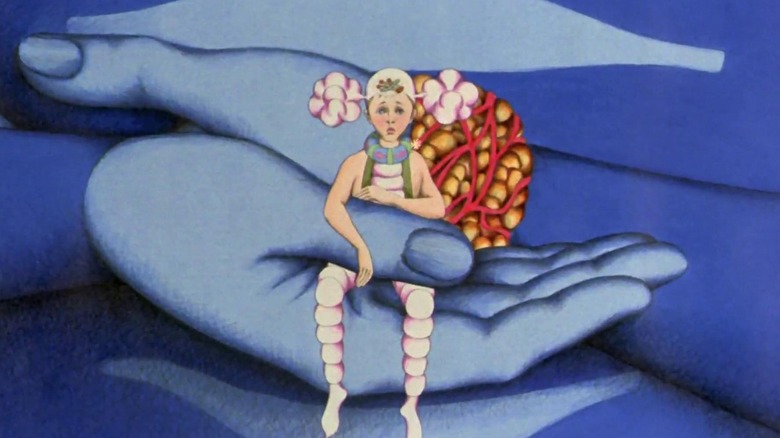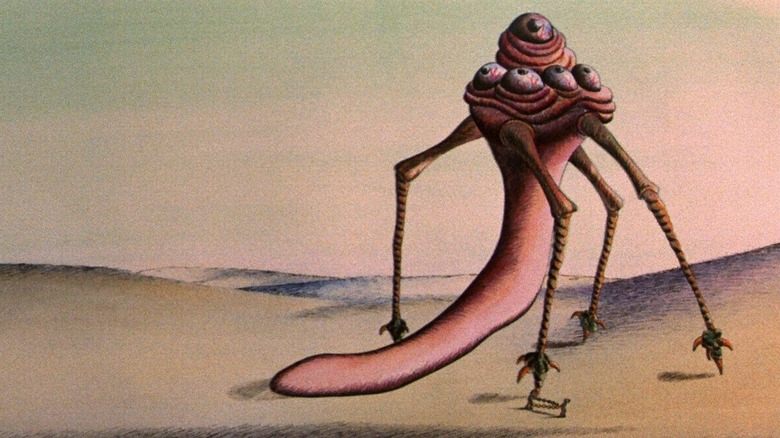This Surreal French Animated Classic Is The Best Sci-Fi Film Of The '70s (Sorry, Star Wars)
We may receive a commission on purchases made from links.
It's all too rare that science fiction, as a genre, lives up to its potential. Science fiction is the one genre that can look into the infinity of the cosmos and allow the imagination to ponder the unfathomable mysteries therein. How can life evolve on other worlds? How does time function? How large does humanity loom in the galactic neighborhood? Are we significant at all, or a mere blip in the eternity of time? How many galaxies are created and destroyed with every eons-long lung-like breath of the expanding and contracting universe?
And what would alien life-forms look like? What would be their makeup, their look, their customs? Thanks to the popularity of "Star Trek" and "Star Wars," aliens have been reduced to humans with facial prosthetics or animal-like CGI creations that merely possess different — and very understandable cultural customs. It's too rare that a movie alien will seem, well, truly alien. Something we cannot understand. Something humanity's brain can't even begin to ruminate on correctly.
That quality is present in spades in René Laloux's 1973 animated film "Fantastic Planet," one of the best films of the 1970s, and one of the best science fiction films of all time. "Fantastic Planet" is like a dream of another world, a strange, contemplative film wherein humans can relate to some of the story, but will be lost in others. It's been said that alien technology would look like magic to a primitive human, but it may be more accurate to say that it would look like a disjointed, chaotic nightmare. "Fantastic Planet" mercifully and imaginatively contains that vital chaos. It's an exhilarating film.
Fantastic Planet makes aliens feel alien
"Fantastic Planet" takes place on a distant world called Ygam. The denizens of this world are blue-skinned humanoids called Draags. Draags have large, round, lidless red eyes and little bat-like wings for ears. They are all peaceful intellectuals who, as children, learn about the mysteries of the cosmos via head-mounted, brain-implanting teaching devices. Adult Draags aspire to spiritual fulfillment, and often scrmable their bodies and project their consciousnesses to distant worlds.
They also keep pets in the form of Oms, teeny tiny humanoids that look an awful lot like humans. In the novel on which "Fantastic Planet" is based — Stefan Wul's 1957 work "Oms en Série" — it's more explicitly stated that the Oms are indeed humans, culled from Earth and taken to Ygam to be pets. "Oms" sounds like "hommes," the French word for "men." In the movie, it's not quite as explicit, and one can easily imagine that the Oms are too far removed from Earth or humanity to be considered human any longer. It's also the very distant future, too distant to ponder.
Draags are centuries-old giants to the tiny humans, who either live in homes inside posh cages or run free in parks like vermin. The central Om is a boy named Terr who is being raised by the young Draag Swia. She dotes on Terr, which concerns her stern parents; they don't like her sentimentality toward this little dumb animal. She keeps him in line with a high-tech collar that can drag him as if on an invisible leash. Trouble brews when Terr manages to get a hold of Siwa's teaching device. Eventually, Terr will become an adult and escape into the surreal landscapes of Ygam, a stranger in a very, very strange land.
Fantastic Planet is almost entirely removed from humanity
Thanks to its animated medium, "Fantastic Planet" can visually go places that live-action sci-fi movies cannot. When the camera pans over a weird alien landscape, we cannot be sure of what anything is. Some creatures appear to be plants, or vice versa. The creatures look like illustrations out of Luigi Serafini's notoriously untranslated alien tome, "The Codex Seraphinianus." Matter is mutable, and the planet itself seems to be made of partially psychic materials. Into this alien landscape, Terr will flee and encounter other Oms like himself. The Oms have formed a society of their own and tribes that war with each other. Eventually, the Oms will conclude that the Draags are their enemy, as Oms are routinely exterminated every year (or several decades, if you're an Om).
The message, of course, is that the Draags, while devoted to art and intellect, are still barbaric enough to keep pets as, essentially, slaves. No matter how wise we think we might be, and no matter how broad our consciousness, we are still at risk of overlooking something, forgetting a grievous moral slip-up. "Fantastic Planet" ends not with a war, but with diplomacy. The planet of the title is one of Ygam's moons, a world where Oms may live in harmony. Will two species open up an intellectual and cultural exchange?
But there is no sense that "Fantastic Planet" is geocentric; it doesn't presume that the fate of humans is at stake. Instead, it's about a shaky beginning between two species that have to emerge from a relationship of dominance and submission. The film is ultimately about peace. Dreams and peace. Intellect, understanding, compassion, and other things humans cannot understand. It's an amazing film.
"Fantastic Planet" can be streamed on the Criterion Channel.


